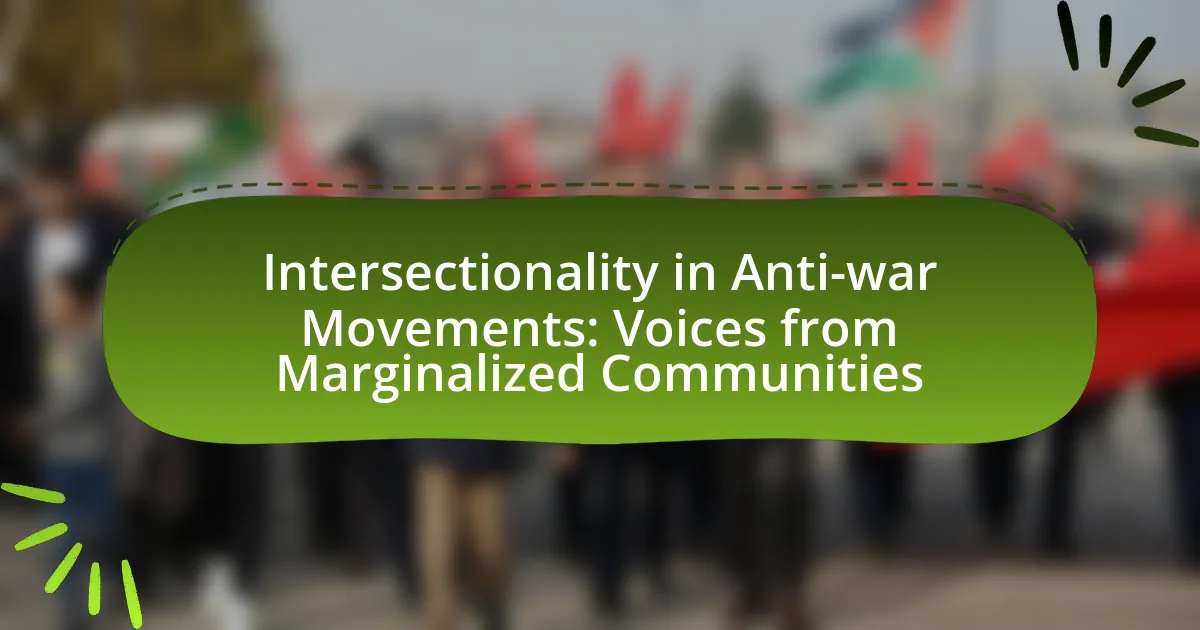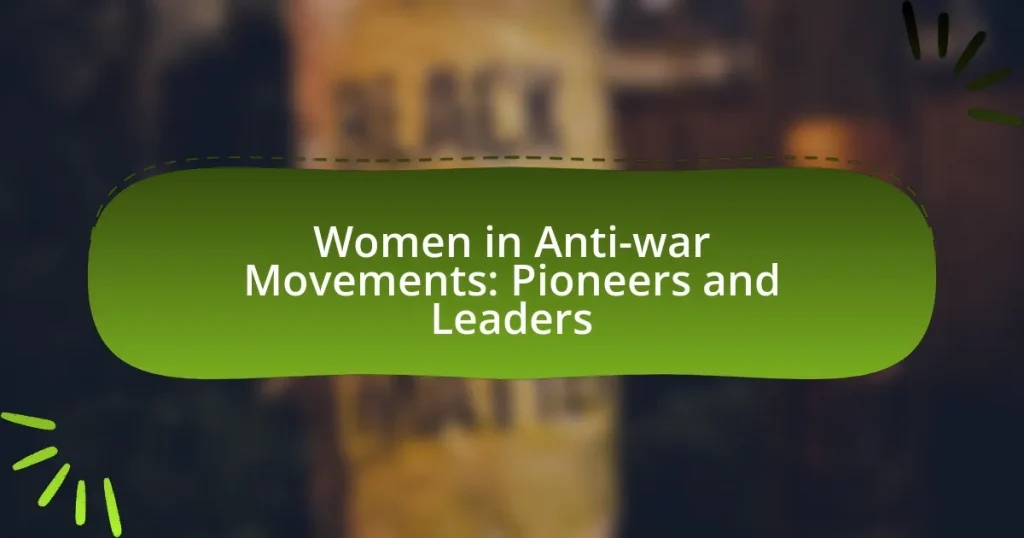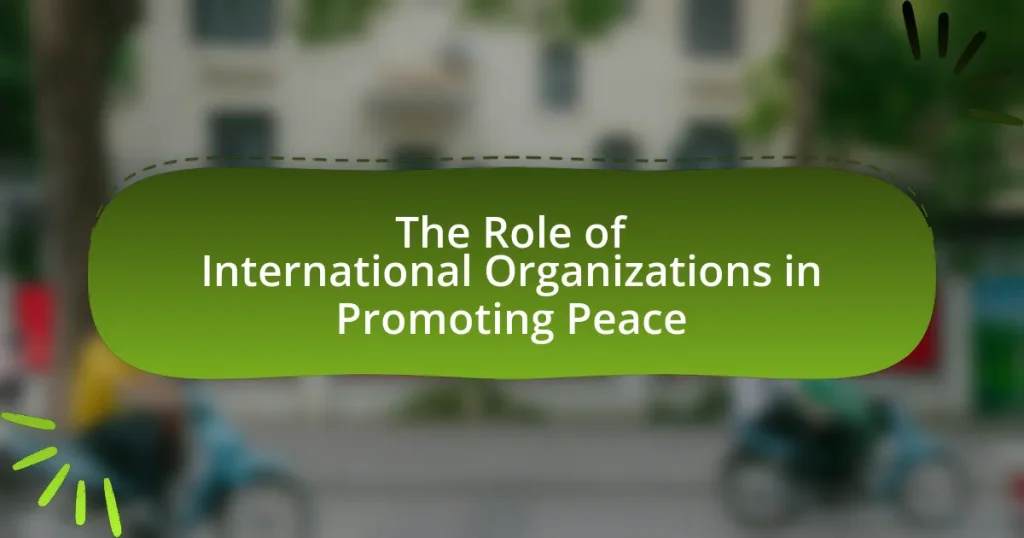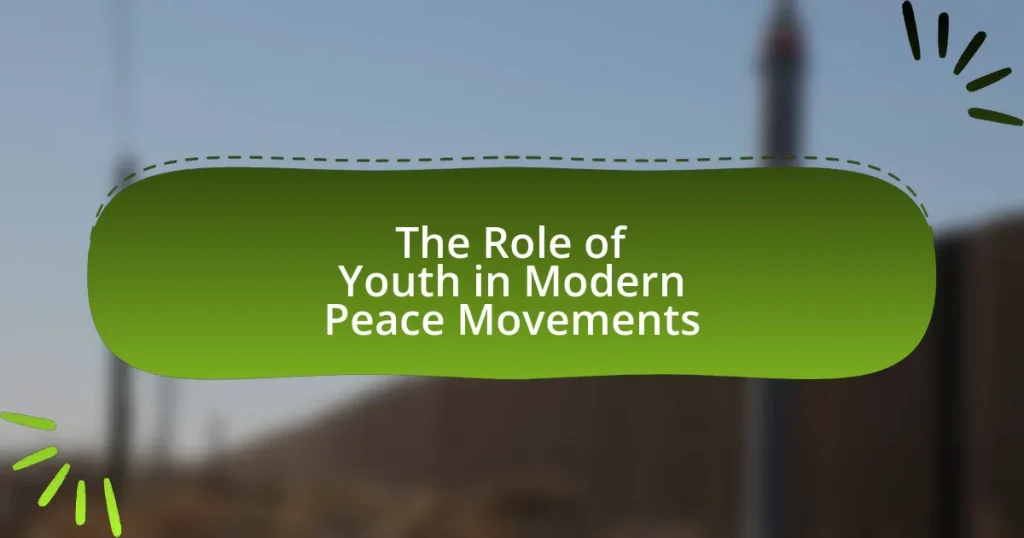Intersectionality in anti-war movements examines how overlapping social identities, such as race, gender, class, and sexuality, shape individuals’ experiences and activism related to war and militarism. The article highlights the unique challenges faced by marginalized communities, emphasizing the importance of inclusive representation and diverse perspectives in anti-war narratives. It discusses the systemic inequalities that hinder participation and the barriers marginalized groups encounter when voicing their concerns. Additionally, the article outlines strategies for fostering collaboration among diverse groups and the role of education in empowering these communities, ultimately advocating for a more effective and equitable approach to anti-war activism.
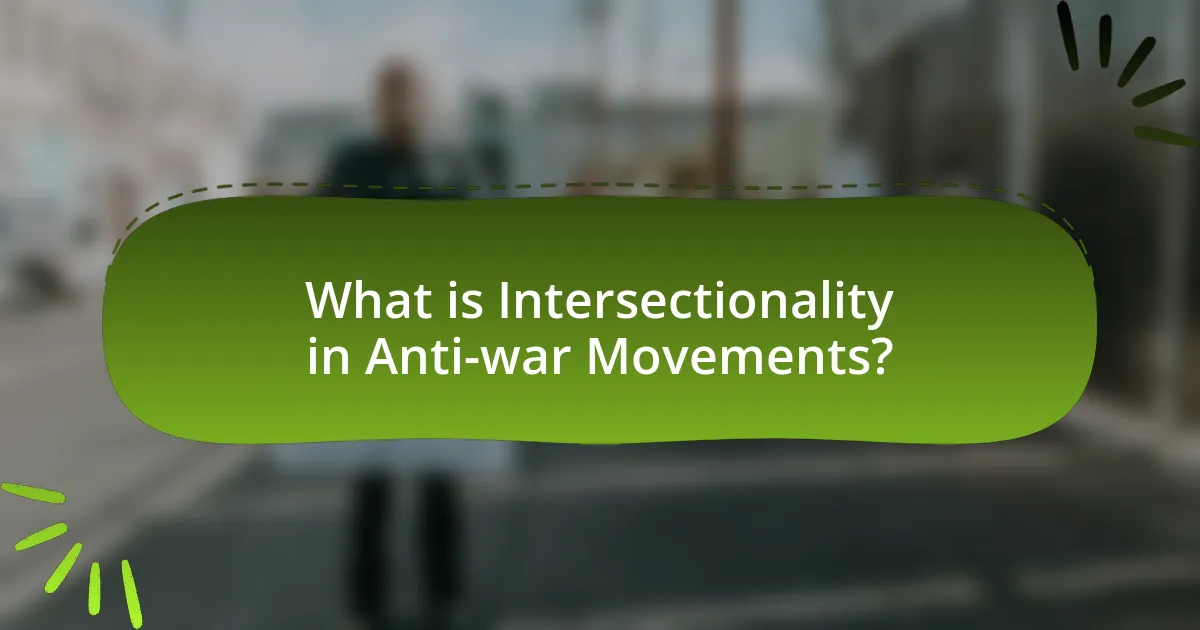
What is Intersectionality in Anti-war Movements?
Intersectionality in anti-war movements refers to the framework that examines how various social identities, such as race, gender, class, and sexuality, intersect to shape individuals’ experiences and perspectives on war and militarism. This approach highlights that marginalized communities often face unique challenges and forms of oppression that are compounded by their intersecting identities, influencing their activism and responses to war. For instance, women of color may experience the impacts of militarism differently than white men, as their activism often addresses both gender-based violence and racial injustice. This understanding is supported by scholars like Kimberlé Crenshaw, who coined the term “intersectionality” to illustrate how overlapping social identities can lead to distinct forms of discrimination and disadvantage.
How does intersectionality shape the narratives within anti-war movements?
Intersectionality shapes the narratives within anti-war movements by highlighting how various social identities, such as race, gender, and class, intersect to influence individuals’ experiences and perspectives on war. This framework allows for a more nuanced understanding of how marginalized communities are disproportionately affected by militarism and conflict, as evidenced by the increased rates of violence against women of color in war zones and the economic hardships faced by low-income families during military engagements. By centering these diverse voices, anti-war movements can address the specific needs and concerns of all affected groups, fostering solidarity and inclusivity in their activism.
What are the key components of intersectionality in this context?
The key components of intersectionality in the context of anti-war movements include the recognition of overlapping social identities, the impact of systemic oppression, and the importance of inclusive representation. Overlapping social identities, such as race, gender, class, and sexuality, shape individuals’ experiences and perspectives on war and peace. Systemic oppression refers to how various forms of discrimination intersect, affecting marginalized communities disproportionately during conflicts. Inclusive representation ensures that the voices of these communities are heard and considered in anti-war activism, highlighting the need for diverse perspectives to address the complexities of war. These components are essential for understanding how different groups experience and respond to militarization and conflict.
How do different identities intersect to influence anti-war activism?
Different identities intersect to influence anti-war activism by shaping individuals’ perspectives, experiences, and motivations for engagement. For instance, race, gender, socioeconomic status, and sexual orientation can create unique viewpoints on the impacts of war, leading to diverse forms of activism. Research indicates that marginalized communities often face disproportionate consequences from military actions, which can galvanize them to advocate for peace. A study by Crenshaw (1989) on intersectionality highlights how overlapping social identities can lead to distinct forms of discrimination and activism, emphasizing that anti-war movements benefit from the inclusion of these varied voices to address the multifaceted nature of conflict and its repercussions.
Why is it important to include marginalized voices in anti-war movements?
Including marginalized voices in anti-war movements is crucial because these perspectives often highlight the disproportionate impacts of war on vulnerable populations. Historical evidence shows that marginalized communities, such as people of color, women, and low-income individuals, frequently bear the brunt of conflict, facing higher rates of violence, displacement, and economic hardship. For instance, the United Nations reports that women and children make up 80% of those displaced by conflict, underscoring the need for their voices in shaping anti-war narratives. By incorporating these perspectives, movements can address systemic inequalities and advocate for comprehensive solutions that consider the experiences and needs of all affected groups, ultimately leading to more effective and inclusive advocacy against war.
What impact do marginalized communities have on the effectiveness of anti-war efforts?
Marginalized communities significantly enhance the effectiveness of anti-war efforts by bringing diverse perspectives and experiences that challenge dominant narratives. Their unique insights often highlight the disproportionate impacts of war on vulnerable populations, fostering a more inclusive dialogue that resonates with broader audiences. For instance, research indicates that movements led by marginalized groups, such as women of color, have historically mobilized substantial grassroots support and raised awareness about the intersection of militarism and social justice, as seen in the work of organizations like Women of Color for Change. This intersectional approach not only amplifies voices often overlooked but also strengthens coalitions across various social movements, thereby increasing the overall impact of anti-war initiatives.
How can the inclusion of diverse perspectives enhance the movement’s goals?
The inclusion of diverse perspectives enhances the movement’s goals by fostering a more comprehensive understanding of the issues at hand. When anti-war movements incorporate voices from marginalized communities, they address the multifaceted impacts of war, such as economic inequality, racial injustice, and gender-based violence. Research indicates that movements that embrace intersectionality are more effective in mobilizing support and creating inclusive policies, as they resonate with a broader audience. For instance, the Women’s March in 2017 highlighted various social justice issues, demonstrating that diverse perspectives can unify different groups under a common cause, ultimately strengthening the movement’s impact and reach.
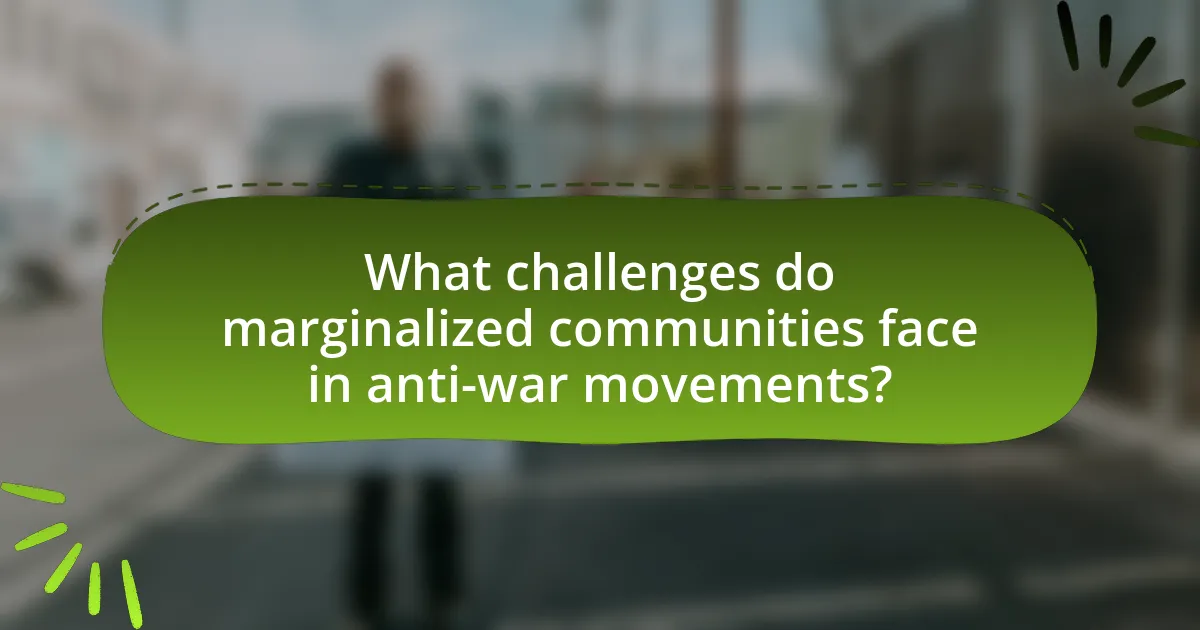
What challenges do marginalized communities face in anti-war movements?
Marginalized communities face significant challenges in anti-war movements, primarily due to systemic inequalities and lack of representation. These communities often experience exclusion from decision-making processes, which limits their ability to influence anti-war agendas that directly affect them. For instance, historical patterns show that marginalized groups, such as people of color and low-income individuals, are disproportionately impacted by military actions and policies, yet their voices are frequently sidelined in mainstream anti-war discourse. Additionally, they may encounter barriers such as limited access to resources, which hampers their organizational capacity and participation in protests or advocacy efforts. Research indicates that these systemic barriers contribute to a cycle of disenfranchisement, making it difficult for marginalized communities to effectively mobilize and advocate for peace.
How do systemic inequalities affect participation in anti-war activism?
Systemic inequalities significantly hinder participation in anti-war activism by creating barriers based on race, class, gender, and other social factors. These inequalities often result in marginalized communities facing economic hardships, limited access to resources, and social stigmatization, which can discourage their involvement in activism. For instance, research by the American Psychological Association indicates that individuals from lower socioeconomic backgrounds are less likely to engage in activism due to the pressures of survival and the lack of time and financial resources to dedicate to such efforts. Additionally, systemic racism can lead to a lack of representation and voice within anti-war movements, further alienating those who are most affected by war. This dynamic perpetuates a cycle where the perspectives and needs of marginalized groups are overlooked, ultimately weakening the overall effectiveness of anti-war activism.
What barriers do marginalized groups encounter when voicing their concerns?
Marginalized groups encounter several barriers when voicing their concerns, including systemic discrimination, lack of access to platforms, and social stigma. Systemic discrimination often manifests in policies and practices that exclude these groups from decision-making processes, limiting their ability to influence outcomes. Additionally, marginalized individuals frequently lack access to mainstream media and advocacy platforms, which hinders their ability to share their perspectives widely. Social stigma can further silence these voices, as fear of backlash or invalidation may discourage individuals from speaking out. Research indicates that these barriers contribute to the underrepresentation of marginalized communities in public discourse, as highlighted in studies on social justice and advocacy.
How do socio-economic factors influence engagement in anti-war movements?
Socio-economic factors significantly influence engagement in anti-war movements by shaping individuals’ access to resources, education, and social networks. Individuals from lower socio-economic backgrounds often experience heightened vulnerability to the impacts of war, such as displacement and economic instability, which can motivate them to participate in anti-war activism. For instance, research indicates that communities with higher poverty rates are more likely to mobilize against military actions that threaten their livelihoods, as seen in various protests against military interventions in economically disadvantaged areas. Additionally, access to education can enhance awareness of global issues, leading to increased activism; studies show that individuals with higher educational attainment are more likely to engage in social movements, including anti-war efforts. Thus, socio-economic status directly correlates with the likelihood of participation in anti-war movements, as it affects both the motivations and the means to engage in activism.
What strategies can be employed to overcome these challenges?
To overcome challenges in intersectionality within anti-war movements, inclusive coalition-building strategies can be employed. These strategies involve actively engaging diverse marginalized communities to ensure their voices and experiences are represented in the movement. Research indicates that movements that prioritize intersectionality, such as the Women’s March, have successfully mobilized a broader base by addressing the unique concerns of various groups, thereby enhancing solidarity and collective action. Additionally, implementing educational initiatives that raise awareness about the interconnectedness of social justice issues can foster understanding and collaboration among different communities, further strengthening the movement’s impact.
How can coalitions be formed to amplify marginalized voices?
Coalitions can be formed to amplify marginalized voices by bringing together diverse groups that share common goals and experiences. This process involves identifying key stakeholders from various marginalized communities, fostering inclusive dialogue, and establishing shared objectives that address specific issues faced by these groups. Research shows that successful coalitions often utilize frameworks like the “Collective Impact Model,” which emphasizes collaboration across sectors to create systemic change. For instance, the “Building Movement Project” highlights how coalitions can effectively mobilize resources and amplify voices through strategic partnerships and community engagement initiatives.
What role does education play in empowering marginalized communities within the movement?
Education plays a crucial role in empowering marginalized communities within the anti-war movement by providing knowledge, skills, and critical awareness necessary for advocacy and activism. Through education, individuals gain an understanding of their rights, the socio-political context of conflicts, and the mechanisms of systemic oppression, which enables them to articulate their experiences and demands effectively. For instance, educational programs that focus on social justice and peacebuilding have been shown to increase civic engagement among marginalized groups, leading to greater participation in advocacy efforts. Research indicates that communities with higher levels of education are more likely to mobilize and influence policy changes, demonstrating the direct correlation between education and empowerment in social movements.

How can intersectionality inform the future of anti-war movements?
Intersectionality can inform the future of anti-war movements by highlighting the interconnectedness of various social identities and their unique experiences of oppression. This framework allows activists to understand how factors such as race, gender, class, and sexuality intersect to shape individuals’ experiences with war and militarism. For instance, research by the Women’s International League for Peace and Freedom demonstrates that women of color often face distinct challenges in conflict zones, which are overlooked in traditional anti-war narratives. By incorporating intersectional perspectives, anti-war movements can create more inclusive strategies that address the specific needs and voices of marginalized communities, ultimately leading to a more effective and equitable approach to peacebuilding.
What lessons can be learned from past anti-war movements regarding intersectionality?
Past anti-war movements demonstrate that intersectionality is crucial for building inclusive coalitions and addressing the diverse impacts of war on marginalized communities. For instance, during the Vietnam War protests, activists highlighted how race, gender, and class intersected, revealing that women of color faced unique challenges and experiences compared to their white counterparts. This recognition led to more comprehensive advocacy that included voices from various backgrounds, such as the Black Women’s Movement, which emphasized the dual oppression faced by Black women. Furthermore, the anti-war movement against the Iraq War saw increased participation from LGBTQ+ activists, who underscored how militarism disproportionately affects queer individuals. These historical examples illustrate that acknowledging intersectionality not only strengthens movements but also ensures that the needs and perspectives of all affected groups are represented, ultimately leading to more effective and equitable outcomes.
How have historical movements successfully integrated intersectional approaches?
Historical movements have successfully integrated intersectional approaches by recognizing and addressing the interconnectedness of various social identities and injustices. For example, the Civil Rights Movement in the United States incorporated the voices of women, LGBTQ+ individuals, and people of color, highlighting how race, gender, and sexuality intersect to shape experiences of oppression. This integration was evident in the work of activists like Audre Lorde and bell hooks, who emphasized the importance of including diverse perspectives to create a more comprehensive understanding of social justice. Additionally, the anti-war movements of the 1960s and 1970s often aligned with feminist and anti-colonial struggles, illustrating how the fight against militarism was linked to broader issues of inequality and systemic violence. These historical examples demonstrate that successful integration of intersectional approaches leads to more inclusive and effective advocacy for marginalized communities.
What mistakes should current movements avoid based on past experiences?
Current movements should avoid the mistake of marginalizing voices from within their own ranks, as seen in past anti-war movements where the perspectives of marginalized communities were often overlooked. For instance, during the Vietnam War protests, the contributions of women, people of color, and LGBTQ+ individuals were frequently sidelined, leading to a lack of comprehensive representation and solidarity. This exclusion not only weakened the movements but also perpetuated existing inequalities. By ensuring that all voices are included and valued, current movements can foster a more inclusive and effective approach to advocacy.
What practical steps can activists take to ensure inclusivity in anti-war efforts?
Activists can ensure inclusivity in anti-war efforts by actively engaging marginalized communities in the planning and execution of campaigns. This involves creating spaces for dialogue where diverse voices can share their experiences and perspectives, ensuring that the narratives of those most affected by war are prioritized. For instance, research shows that movements that incorporate the voices of women, people of color, and LGBTQ+ individuals are more effective in addressing the multifaceted impacts of war. Additionally, providing resources and support for these communities to lead initiatives fosters ownership and empowerment, which is crucial for genuine inclusivity.
How can grassroots organizations implement intersectional frameworks effectively?
Grassroots organizations can implement intersectional frameworks effectively by actively engaging diverse community members in decision-making processes. This approach ensures that the unique experiences and needs of marginalized groups are recognized and addressed. For instance, organizations can conduct inclusive workshops and focus groups that prioritize voices from various identities, such as race, gender, and socioeconomic status. Research shows that intersectional approaches lead to more comprehensive solutions, as highlighted in the report “Intersectionality Matters!” by the African American Policy Forum, which emphasizes the importance of centering marginalized voices in advocacy efforts. By integrating these practices, grassroots organizations can create more equitable and impactful anti-war movements that resonate with the complexities of their communities.
What best practices can be adopted to foster collaboration among diverse groups?
To foster collaboration among diverse groups, organizations should implement inclusive communication strategies. These strategies involve actively listening to all voices, ensuring that everyone feels valued and heard, which is crucial for building trust and understanding. Research indicates that inclusive practices lead to better decision-making and innovation, as diverse perspectives contribute to more comprehensive solutions. For instance, a study by the Harvard Business Review found that teams with diverse members are 35% more likely to outperform their homogeneous counterparts. Additionally, establishing common goals and shared values can unify diverse groups, promoting a sense of belonging and collective purpose.
